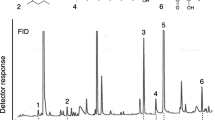Abstract
Several African termite species from different subfamilies and different habitats are sensitive to trail-active extracts or to naturally laid trails from other species. Using single-extract bioassays, it is shown that the response threshold for trail-following is nearly identical for all tested species (except forHodotermes mossambicus). However, when termite workers have a choice between trails from their own species and from other species, conspecific trail-following is exclusively observed. This phenomenon can be counteracted by dilution (1∶10) of the conspecific trail-pheromone extract. Tests of the trail activity of various synthetic alcohols show that among these, the highest sensitivity of termite workers is to (Z)-3-dodecen-1-ol. Based on our experimental data, we postulate that, in addition to a generally active trail-pheromone constituent (an unsaturated primary C12 alcohol) or a pool of chemically closely related alcohols, other species-specific components are present in termite trails.
Similar content being viewed by others
References
Akkerboom, P.J. 1974. Dodecatrienolen als spoorvolg feromoon. Synthese en biologiese aktivitieit. Thesis, Utrecht.
Beroza, M. 1975. Microanalytical methodology relating to the identification of insect sex pheromones and related behaviour-control chemicals.J. Chromatogr. Sci. 13:314–321.
Birch, A.J., Brown, W.V., Corrie, J.E.T., andMoore, B.P. 1972. Neocembrene-A, a termite trail pheromone.J. Chem. Soc. Perkin Trans. 1:2653–2658.
Blum, M.S. 1974. Pheromonal bases of social manifestations in insects, pp. 190–199,in M.C. Birch (ed.). Pheromones. American Elsevier, New York.
Hölldobler, B. 1977. Communication in social Hymenoptera, pp. 418–471,in Th. A. Sebeok (ed.). How Animals Communicate. Indiana University Press, Bloomington.
Howard, R., Matsumura, F., andCoppel, H.C. 1976. Trail-following pheromones of the Rhinotermitidae: Approaches to their authentication and specificity.J. Chem. Ecol. 2:147–166.
Hummel, H. 1968. Chemische Anreicherungsversuche zum Studium eines spurwirksamen Pheromons der TermiteZootermopsis nevadensis Hagen.Insectes Soc. 15:213–216.
Hummel, H., andKarlson, P. 1968. Hexansäure als Bestandteil des Spurpheromons der TermiteZootermopsis nevadensis Hagen.Hoppe-Seyler's Z. Physiol. Chem. 349:725–727.
Kaib, M., andLeuthold, R.H. 1982. Mechanisms of chemical Orientation by termite workers of the speciesHodotermes mossambicus andSchedorhinotermes lamanianus. In preparation.
Karlson, H., Lüscher, M., andHummel, H. 1968. Extraktion und biologische Auswertung des Spurpheromons der TermiteZootermopsis nevadensis.J. Insect Physiol. 14:1763–1771.
Larue, J.L., andBarbier, M. 1976. Sur la pheromone de piste du termiteSchedorhinotermes lamanianus.C.R. Acad. Sci. Paris, Ser. D. 282:1897–1900.
Leuthold, R.H., andLüscher, M. 1974. An unusual caste polymorphism of the sternal gland in the termiteTrinervitermes bettonianus.Insectes Soc. 21:335–341.
Leuthold, R.H., Bruinsma, O., andvan Huis, A. 1976. Optical and pheromonal orientation and memory for homing distance in the harvester termiteHodotermes mossambicus Hagen.Behav. Ecol. Sociobiol. 1:127–139.
Matsumura, F., Coppel, H.C., andTai, A. 1968. Isolation and identification of termite trail pheromone.Nature 219:963–964.
Matsumura, F., Tai, A., andCoppel, H.C. 1969. Termite trail-following substance, isolation and purification fromReticulitermes virginicus and from fungus-infected wood.J. Econ. Entomol. 62:599–603.
Matsumura, F., Jewett, D.M., andCoppel, H.C. 1972. Interspecific response of termites to synthetic trail-following substances.J. Econ. Entomol. 65:600–602.
Matsumura, F., Nishimoto, K., Ikeda, T., andCoppel, H.C. 1976. Influence of carbon sources on the production of termite trail-following substance byGloeophyllum trabeum.J. Chem. Ecol. 2:299–305.
Moore, B.P. 1966. Isolation of the scent-trail pheromone of an Australian termite.Nature 211:746–747.
Moore, B.P. 1974. Pheromones in termite societies, pp. 250–266,in M.C. Birch (ed.). Pheromones, American Elsevier, New York.
Priesner, E. 1973. Artspezifität und Funktion einiger Insektenpheromone.Fortschr. Zool. 22:49–135.
Quennedey, A. 1977. An ultrastructural study of the polymorphic sternal gland inReticulitermes santonensis (Isoptera, Rhinotermitidae); Another way of looking at the true termite trail-pheromone. Proc. VIIIth Int. Congr. IUSSI, Wageningen, pp. 48–49.
Ritter, F.J., andPersoons, C.J. 1977. Trail pheromones and related compounds in termites and ants. Proc. VIIIth Int. Congr. IUSSI, Wageningen, pp. 34–38.
Stuart, A.M. 1963. Origin of the trail in the termitesNasutitermes corniger (Motschulsky) andZootermopsis nevadensis (Hagen), Isoptera.Physiol. Zool. 36:69–84.
Stuart, A.M. 1969. Social behaviour and communication, pp. 193–232,in K. Krishna, and F.M. Weesner, (eds.). Biology of Termites, Vol. 1. Academic Press, New York.
Tai, A., Matsumura, F., andCoppel, H.C. 1969. Chemical identification of the trail-following pheromone for a southern subterranean termite.J. Org. Chem. 34:2180–2182.
Tai, A., Matsumura, F. andCoppel, H.C. 1971. Synthetic analogues of the termite trail-following pheromone, structure and biological activity.J. Insect. Physiol. 17:181–188.
Traniello, J.F.A. 1981. Enemy deterrence in the recruitment strategy of a termite: Soldier-organized foraging inNasutitermes costalis.Proc. Natl. Acad. Sci. U.S.A. 78:1976–1979.
Tschinkel, W.R., andClose, P.G. 1973. The trail pheromone of the termiteTrinervitermes trinervoides.J. Insect Physiol. 19:707–721.
Verron, H., andBarbier, M. 1962. L'hexene-3-ol-1, substance des termitesCalotermes flavicollis etMicrocerotermes edentatus.C.R. Acad. Sci. 254:4089–4091.
Wilson, E.O. 1971. The Insect Societies. Belknap Press, Cambridge, Massachusetts.
Wilson, E.O. 1974. Sociobiology. Belknap Press, Cambridge, Massachusetts.
Author information
Authors and Affiliations
Rights and permissions
About this article
Cite this article
Kaib, M., Bruinsma, O. & Leuthold, R.H. Trail-following in termites: Evidence for a multicomponent system. J Chem Ecol 8, 1193–1205 (1982). https://doi.org/10.1007/BF00990752
Received:
Revised:
Issue Date:
DOI: https://doi.org/10.1007/BF00990752




